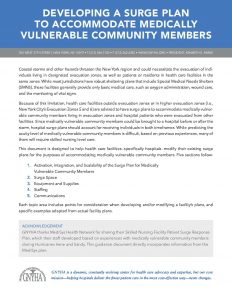Coastal storms and other hazards threaten the New York region and could necessitate the evacuation of individuals living in designated evacuation zones, as well as patients or residents in health care facilities in the same zones. While most jurisdictions have robust sheltering plans that include Special Medical Needs Shelters (SMNS), these facilities generally provide only basic medical care, such as oxygen administration, wound care, and the monitoring of vital signs.
Because of this limitation, health care facilities outside evacuation zones or in higher evacuation zones (i.e., New York City’s Evacuation Zones 5 and 6) are advised to have surge plans to accommodate medically vulnerable community members living in evacuation zones and hospital patients who were evacuated from other facilities. Since medically vulnerable community members could be brought to a hospital before or after the storm, hospital surge plans should account for receiving individuals in both timeframes. While predicting the acuity level of medically vulnerable community members is difficult, based on previous experiences, many of them will require skilled nursing level care.
This document is designed to help health care facilities—specifically hospitals—modify their existing surge plans for the purposes of accommodating medically vulnerable community members. Five sections follow:
- Activation, Integration, and Scalability of the Surge Plan for Medically Vulnerable Community Members
- Surge Space
- Equipment and Supplies
- Staffing
- Communications
Each topic area includes points for consideration when developing and/or modifying a facility’s plans, and specific examples adapted from actual facility plans.
